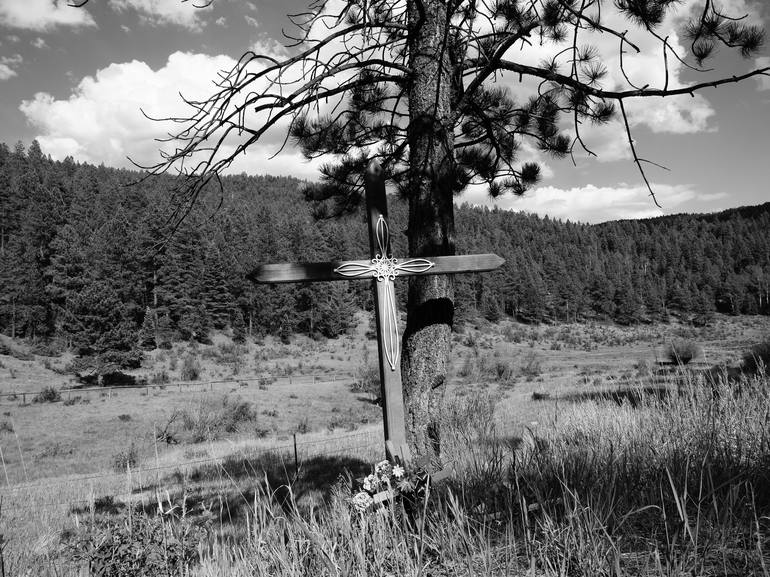


VIEW IN MY ROOM
Generic cross Descansos on US Highway 64 over Palo Flechado Pass and into Taos Photograph
United States
Photography, Black & White on Other
Size: 32 W x 24 H x 0.1 D in
About The Artwork
THE CUSTOM of marking the site of a death on the highway has deep roots in the Hispanic culture of the Southwest, where these memorials are often referred to as Descansos ("resting places"). Traditionally, Descansos were memorials erected at the places where the funeral procession paused to rest on the journey between the church and the cemetery. The association thus created between the road, the interrupted journey, and death as a destination, eventually found expression in the practice of similarly marking the location of fatal accidents on the highway. Unmarked memorials; near Ca�on City, Colorado"THE FIRST DESCANSOS were resting places where those who carried the coffin from the church to the camposanto paused to rest. In the old villages of New Mexico, high in the Sangre de Cristo Mountains or along the river valleys, the coffin was shouldered by four or six men. "Led by the priest or preacher and followed by mourning women dressed in black, the procession made its way from the church to the cemetery. The rough hewn pine of the coffin cut into the shoulders of the men. If the camposanto was far from the church, the men grew tired and they paused to rest, lowering the coffin and placing it on the ground. The place where they rested was the descanso. "The priest prayed; the wailing of the women filled the air; there was time to contemplate death. Perhaps someone would break a sprig of juniper and bury it in the ground to mark the spot, or place wild flowers in the ground. Perhaps someone would take two small branches of pi�on and tie them together with a leather thong, then plant the cross in the ground. "Rested , the men would shoulder the coffin again, lift the heavy load, and the procession would continue. With time, the descansos from the church to the cemetery would become resting spots. . . . "Time touches everything with change. The old descanso became the new as the age of the automobile came to the provinces of New Mexico. How slow and soft and deeper seemed the time of our grandfathers. Horses or mules drew the wagons. 'Voy a preparar el carro de vestia,' my grandfather would say. I remember the sound of his words, the ceremony of his harnessing the horses. "Yes, there have always been accidents, a wagon would turn over, a man would die. But the journeys of our grandfathers were slow, there was time to contemplate the relationship of life and death. Now time moves fast, cars and trucks race like demons on the highways, there is little time to contemplate. Death comes quickly, and often it comes to our young. Time has transformed the way we die, but time cannot transform the shadow of death. "I remember very well the impact of the car on the people of the llano and the villages of my river valley. I remember because I had a glimpse of the old way, the way of my grandfather, and as a child I saw the entry of the automobile. "One word describes the change for me: violence. The cuentos of the people became filled with tales of car wrecks, someone burned by gasoline while cleaning a carburetor, someone crippled for life in an accident. The crosses along the country roads increased. Violent death had come with the new age. Yes, there was utility, the ease of transportation, but at a price. Pause and look at the cross on the side of the road, dear traveler, and remember the price we pay".
Details & Dimensions
Photography:Black & White on Other
Original:One-of-a-kind Artwork
Size:32 W x 24 H x 0.1 D in
Frame:Not Framed
Ready to Hang:No
Shipping & Returns
Delivery Time:Typically 5-7 business days for domestic shipments, 10-14 business days for international shipments.
Have additional questions?
Please visit our help section or contact us.
United States
In his book "˜The portrait of an artist as a young man' James Joyce writes "__And to distinguish between the beautiful and the sublime, to distinguish between moral beauty and material beauty. And to inquire what kind of beauty is proper to each of the various arts. These are some interesting points we might take up." I've always believed the beauty proper to photography is not sublime creation, as in all the other arts, but rather a benevolent gift. When the fortune of a beautiful scene is recorded into my camera, in that inconsequential instant, relative to all of time, I am creating nothing. I am given something... like the best Christmas present ever or the love of a best friend. In that respect, photography is more a moral beauty art, as opposed to a material beauty art. The first time I became aware of this was in a small art studio in Paris France, where I discovered a black and white photograph of a young woman. What interested me most was the ambiguity of the subject's expression. She appeared pleasant and pleased. But there was a tear about to fall from her right eye. The image gave me goose bumps and soon after I bought my first camera. 40 years later, I was given the "˜gifts of light' I am displaying on Saachi.
markgoebel.photoshelter.com/ The Stock Photo Agency I own: www.painetworks.com The Videos I produced: www.youtube.com/user/PainetInc
Thousands Of Five-Star Reviews
We deliver world-class customer service to all of our art buyers.
Global Selection
Explore an unparalleled artwork selection by artists from around the world.
Satisfaction Guaranteed
Our 14-day satisfaction guarantee allows you to buy with confidence.
Support An Artist With Every Purchase
We pay our artists more on every sale than other galleries.
Need More Help?